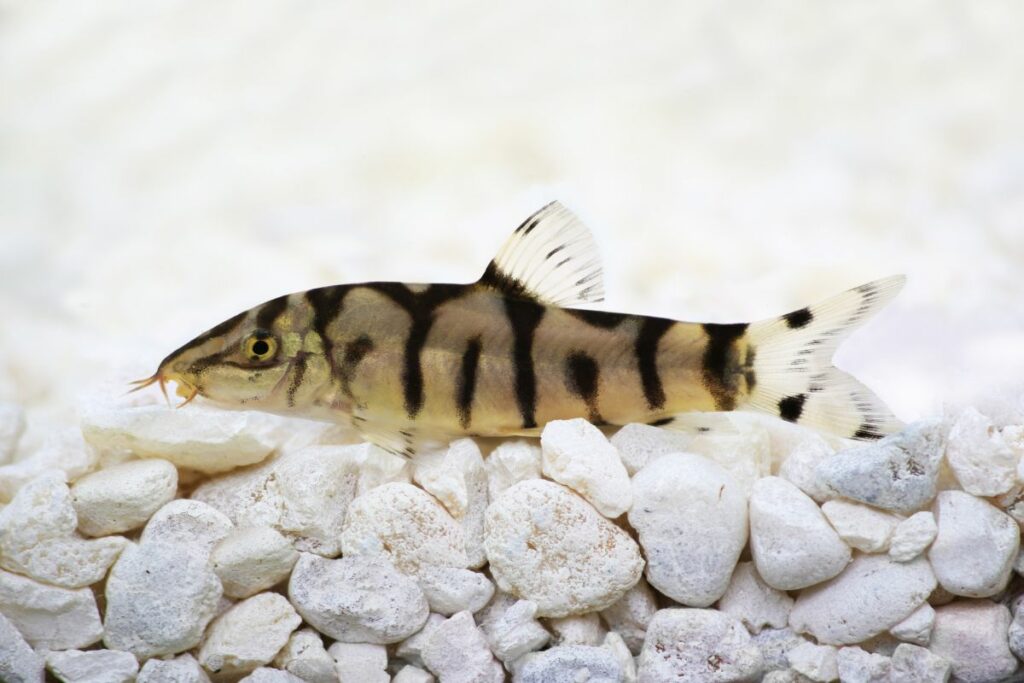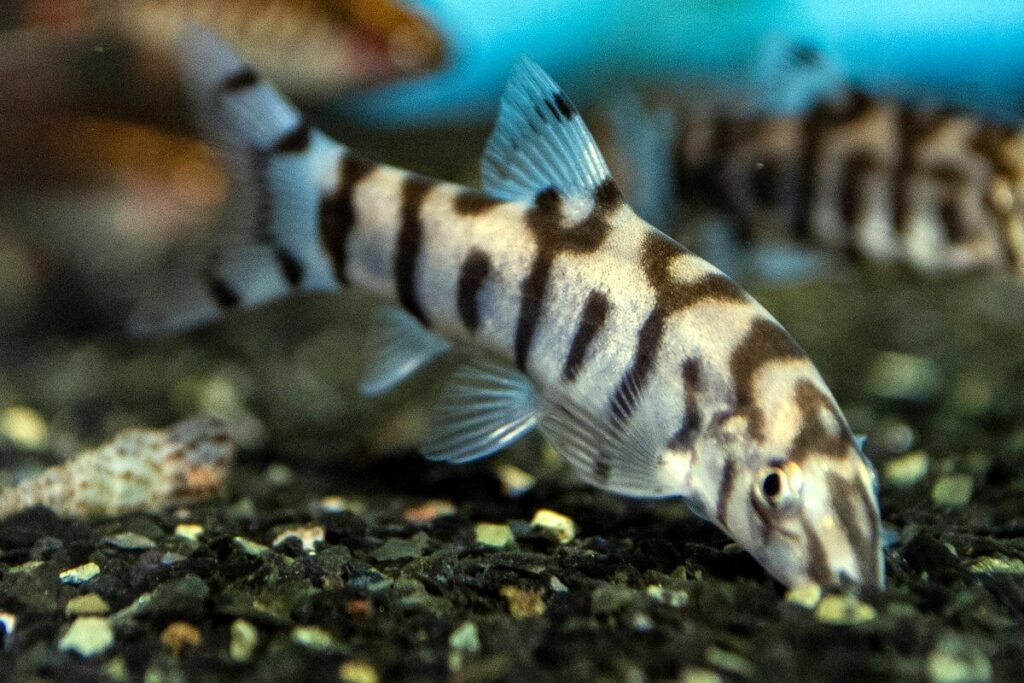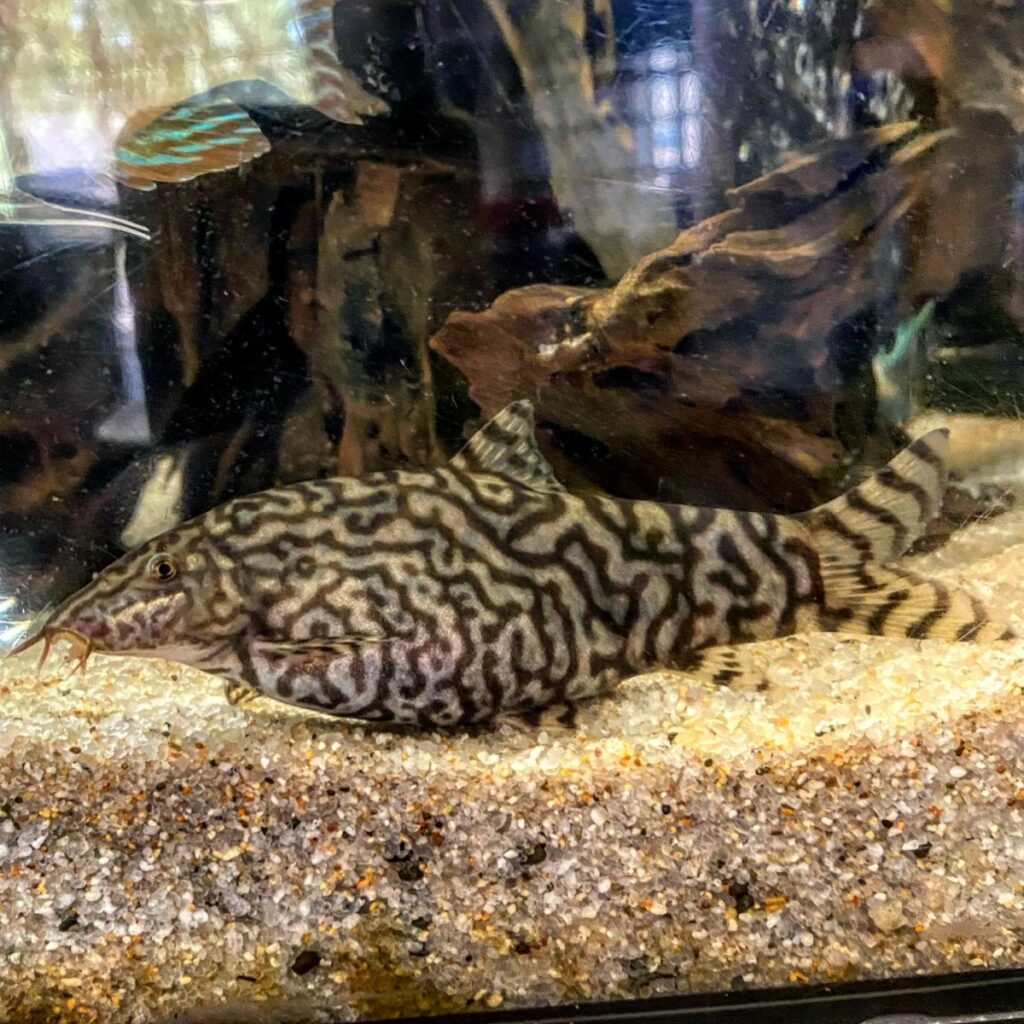The yoyo loach gets its name from the twisted stripes along its flanks. They seem to spell out the word “yo yo,” making them an instant aquarium favorite. Yoyo loaches are also active and undemanding pets that are a good addition for most community tanks.

What is the Yoyo Loach?
Yoyo loaches are better thought of as a species complex: a group of different species that are all close relatives. That’s why there is a lot of confusion when you look for information about the yoyo loach.
Even the scientific name and origin gets difficult. Botia almorhae is the yoyo loach you most often encounter in pet stores.
All of the species come from Pakistan, North India, and Nepal. They also have identical care requirements. So it’s not super important to sort out which kind of yoyo loach you have.
Yoyo loaches are one of the smallest members of the family Botiidae. There are several members of the group that are regular additions to the aquarium hobby. But the yoyo loach is one of the most popular; only the clown loach is more common.
Loaches are active, often grow large, and several are pretty aggressive fish. The yoyo loach is an exception since it stays small and is more peaceful. All loaches do have a weapon they employ at times: a switchblade-like barb hidden right under their eyes.
Loaches use it similar to the tail blade of a marine surgeonfish: they slash and stab with it if threatened. The barb isn’t venomous but it is sharp enough to draw blood.
Yoyo loach spines sometimes get tangled up in nets when caught. So be cautious when netting one as the spine might stick you through the mesh.
- Common Names: Yoyo Loach, Alora Loach, Pakistani Loach
- Scientific Name: Botia almorhae
- Origin: Pakistan, Nepal, & North India
- Length: 2 to 3 inches
- Aquarium Size: 20+ gallons
- Temperament: Peaceful to Semi-Aggressive
- Ease of Care: Easy
Yoyo Loach Care
Like all loaches, the yoyo loach is an easy to care for bottom dwelling aquarium fish. They are also much more sociable than other loaches and do well in small groups.
Yoyo Loach Size
Yoyo loach full size is very manageable for most fish tanks. They grow just 2.5 to 3 inches as adults. Most loaches are in the 4 to 12 inch range. Only the dwarf chain loach (Botia sidthimunki) stays smaller.
Yoyo Loach Tank Size

Given their reasonable size, yoyo loaches do well in smaller tanks. 20 gallons is the absolute minimum, however. These fish are still very active and need as much space as possible. If you’re keeping a group then 30 or 40 gallons is better since they are territorial at times.
Also you are better off keeping a medium sized group of 5+ loaches rather than just 2 or 3. In smaller groups, the least dominant fish will be bullied too often. Which may cause stress and prevent it from eating.
Water Quality for Yoyo Loaches
Water chemistry is not too important for yoyo loaches so long as you avoid the extremes. A pH of 6.5-7.5 is ideal for them and easy to achieve using treated tap water. They also thrive with the hardness levels found in most municipal tap water.
Yoyo loaches are sensitive to aquarium salt, however. so don’t add it unless you are trying to treat a specific disease. And even then, use lower doses to avoid causing stress.
They prefer temperatures of 73-78℉; not too hot or too cool as tropical fish go. Yoyo loaches aren’t too sensitive to ammonia but you still don’t want any measurable levels. Add them last if you’re setting up a new aquarium as they often succumb to new tank syndrome.
Yoyo Loach Health Issues
As scaleless fish, yoyo loaches are prone to skin diseases. Once they catch aquarium fish ich, it is hard to rid them of it for good. Even when you think they are cured, a single loach with a few white spots may reinfect the entire tank. Body and fin fungus are also dangerous for them.
Scaleless fish are also sensitive to medications. They sometimes absorb toxic amounts since scales act as a barrier, slowing absorption for most other fish. Yet you still need to use medication doses that will be effective on parasites, bacteria, and fungi.
I always treat yoyo loaches in a quarantine tank. In this way you are able to monitor with care how much medication goes in. As well as the response your yoyo loach has as it’s treated.
Quarantine tanks also isolate your other fish from stressful medicines or contagious disease.
Yoyo Loach Tank Mates

There is an endless array of suitable yoyo loach tank mates out there. Their small mouths prevent them from being predators. Yoyo loaches are even sociable enough to live alongside their own kind without fighting.
In fact, I recommend keeping them in groups of 5 to 6 individuals. You will need a larger aquarium (40 gallons). But it keeps your yoyo loaches focused on each other, further minimizing any aggression towards tank mates.
Choose fish of a similar size. Yoyo loaches are flexible enough with water quality that the majority of aquarium fish do well with them. Medium sized barbs like tiger barbs and rosy barbs are good schooling fish. As are any of the several species of tetra fish.
Platy fish, dwarf cichlids, gouramis, rainbowfish, and rasboras also thrive alongside yoyo loaches. I would not add any other bottom dwelling fish to the setup, however. Yoyo loaches are sometimes territorial and will chase cory catfish and plecostomus around.
They are much less aggressive than other Botia sp. But yoyo loaches are prone to fin nipping and bullying slower tank mates sometimes. Long finned guppies, fancy goldfish, and betta fish are their favorite targets.
Not all yoyo loaches become bullies. It happens most often when you have a single yoyo loach in a small tank with the above species of fish.
What Do Yoyo Loaches Eat?
Yoyo loaches are omnivorous fish, meaning they need to eat both plant and animal matter. They will eat anything organic, including green algae, worms, small shrimp, insect larvae, and fish eggs.
Aquarium plants with soft leaves are also on the menu. So be careful with adding a yoyo loach to a planted tank. Boiled lettuce, spinach, and zucchini gives them the greenery they need and keeps them from eating your plants. As well as flake food formulas fortified with spirulina algae.
Any pellet food should be small enough to fit in their mouths. Yoyo loaches also enjoy frozen and live foods.
They most enjoy brine shrimp, blood worms, and tubifex worms. Offering invertebrate-sourced foods is also the best way to start breeding yoyo loaches.
Do Yoyo Loaches Eat Snails?
Yoyo loaches eat all sorts of invertebrates. But snails are something all loaches specialize in. They use their elongated snouts to reach right into the shell.
Once they grab ahold of the snail’s flesh, they shake the entire shell like a dog. Tearing the snail from its home to be eaten.
Here is a video that demonstrates how a yoyo loach feeds on pest snails:
Yoyo loaches are one of the few biological control methods for snails that work well. They will reduce or even eliminate snail populations in smaller tanks. They do best with snail types that don’t have an operculum; the hard plug that some snails use to close their shell behind them.
Ramshorn snails and bladder snails don’t have an operculum and are easy prey for yoyo loaches. They are also the most common species of pest snails in fish tanks.
Yoyo Loach Breeding Behavior
Yoyo loach breeding is not an easy matter. They have few visible sexual differences to go by. Captive breeding does happen but it’s often an accident.
One reason why breeding yoyo loaches is rare is because these fish migrate in the wild. They rely on seasonal and environmental cues to know when to spawn. Since aquariums don’t undergo seasonal changes, yoyo loaches aren’t conditioned to spawn.
That said, it does happen. Yoyo loaches living in groups inside of planted tanks spawn the most often. And if you offer frequent feedings of tubifex worms, snails, and brine shrimp, your chances go up even more.
Conclusion
Yoyo loaches are one bottom dwelling fish that aren’t interested in staying hidden. These fish dance around during the day. And even come to the surface to feed with their tank mates. So long as they don’t catch a skin infection, you can look forward to years of fun viewing with yoyo loaches.
FAQs
Loaches in general are not easy to tell the sexes apart. Male yoyo loaches are a little slimmer than females at all times. But if you have a yoyo loach pregnant female the difference is even more obvious. Comparing your fish from above is the easiest way to sex them.
Yoyo loaches are semi-aggressive. They tend to bully slow-moving, long finned fish. As well as other bottom dwellers. But they won’t bother most community fish their size. And if you keep them together, you will reduce aggression even more.
I recommend keeping either a single yoyo loach or buying a group of 5 or more. Smaller numbers may lead to one loach being bullied too often.

